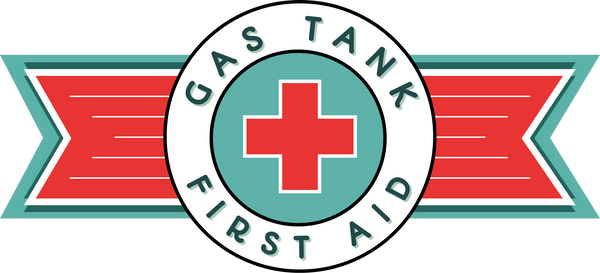Here we will show you our process of tumbling a motorcycle gas tank. This also applies to automove gas tanks as well. We will go over the process step by step so you have a better understanding of what's involved before making a purchase as well as answering any questions or concerns you may have. Let's begin.
First, Before unpacking the gas tank. We begin by inspecting the shipping box. Checking for any obvious signs of shipping damage that may have occurred. We will take pictures of the box as it was received before opening it.
Next, we will unpack the gas tank. Thoroughly look over the gas tank and inspect its condition. Identifying holes, rust, damage to the tank inside and outside. Reviewing the paperwork and order information for the gas tank we received online. We will notify the customer that we have received the gas tank and the condition we received it in. If any shipping damage has occurred. We can assist the customer with pictures to help file their claim with the shipping carrier.
Next, we are going to take pictures of the gas tank before any work is performed. Once pictures are taken. We will prepare the gas tank to be mounted onto the tumbling machine.
Since this motorcycle gas tank has a paint job that needs to be preserved. We are going to wrap the tank in plastic stretch wrap. Before we begin wrapping the tank. We apply Kreem Tank Mask paint protection. Specifically designed to seal off and protect your paint job. After we apply a few coats of Kreem Tank Mask. We wrap the tank in plastic stretch wrap. Yu can do too much of this and prefer at least 15 or more layers. Preserving the gas tanks paint job is the most important detail for us.
Because the gas tank will be filled with fluid and tumbling media. We must plug off any openings and seal the gas tank. We have a lot of various caps, plugs and rubber block off plates on hand to work with.
With the gas tank mounted onto our tumbling machine. Depending on the size of the gas tank. We will fill the gas tank with 30-50 ounces of white vinegar and tumbling media. Having tested several different commercial rust removers. Surprisingly, white vinegar works the best, is safe to handle and won't hurt paint making it great for painted motorcycle gas tanks.
As for our media. Having experimented with different media. What we found to work best is a blend of stainless steel chips combined with 10 grit silicon carbide.
With the media and vinegar loaded inside the tank. We seal off the opening and set the tumbling machine to turn for one hour.
After turning for one hour. We remove the gas tank from the tumbler. Empty the tank out. Rinse it clean with tap water. Inspect the inside of the tank. The first round of tumbling does a really great job of removing most of the rust. It generally takes 2-3 rounds to get the gas tank to where we are satisfied with it.
We mount the tank back onto the tumbler. Load the tank with 30-50 ounces of vinegar and media for round two. Set the tumbling machine for 60 minutes.
After the second hour of tumbling is complete. We remove the gas tank from the tumbling machine. Empty everything out. Rinse the tank clean with water. Inspect the inside. Determine if the tank needs to turn for a third time with vinegar or not. In this case the tank was very clean inside. Now it's time to neutralize the acidity of the vinegar. Best way to do this is with baking soda and water. We load the tank back onto the tumbling machine. Add 30-50 ounces of deionized water, baking soda and our media blend. Set the timer on the machine for 20 minutes.
After turning for 20 minutes. We remove the gas tank. Empty everything out. Rinse the gas tank out. Inspect the inside making sure everything is rinsed out. Now it's time to apply a rust neutralizer. Even though the inside of the gas tank is visibly free of rust. Using a rust neutralizer will penetrate deep into any gas tank seams, welds, threads etc. Dehydrating and neutralizing any rust our media was not able to contact and scrub away. We add approximately 10-20 ounces of Rust Inhibitor #6 along with our media blend. Set the tumbling machine for 20 minutes.
After turning for 20 minutes. We remove the gas tank. Empty everything out. Rinse the gas tank out. Inspect the inside making sure everything is rinsed out. We then quickly blow the inside of the tank dry. Using a combination of compressed air followed by 15 minutes of warm air using a common household hair dryer.

